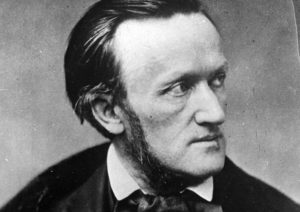Conductor and author Michael Downes explains why and how he chose to trace the creation of Wagner’s masterpiece in his upcoming book.It is often said that there are more books about Wagner than any historical figure other than Napoleon or Jesus. This is not actually true, but the myth’s frequent resurfacing indicates that there are already an awful lot of books about Wagner on the market, many of them recent, thorough, and authoritative.
What reasons, then, could I have for writing another – in particular, one dealing with the “Ring of the Nibelung,” a work so central to the Bayreuth Master’s oeuvre and well covered in existing texts?I had two reasons in particular. Firstly, most existing books are written for listeners who already know the tetralogy and are convinced by the merits of Wagner’s compelling but idiosyncratic blend of diverse myths and his elaborate and original musical techniques. Many of them, for example, catalogue and discuss the ‘leitmotifs’ Wagner uses to represent objects or ideas, but assume existing familiarity with the method and a knowledge of musical notation.

As I wrote “Wagner and the Creation of The Ring” – due for US publication by Pegasus Books on 1 July – I imagined a reader already enthusiastic about classical music, perhaps a regular attendee of operas by Mozart or Puccini and aware of Wagner’s importance, but who had not yet invested the time and money necessary to come to terms with the “Ring.”The second thing that I felt my book could do differently from others was to convey in a concise and accessible way the dizzying range of skills that Wagner brought to bear on the “Ring’s” creation. Apart from his obvious talents as composer, writer, and conductor, Wagner was also an extraordinary entrepreneur, administrator, fundraiser, director, and leader, who inspired those around him to herculean achievements against seemingly impossible odds.
My story begins in 1846, with Wagner three years into his tenure as Royal Saxon Kapellmeister, presiding over one of the most prestigious opera houses in Germany. During his seven years in Dresden, he conducted three new operas – “Rienzi,” “Flying Dutchman,” and “Tannhäuser” – while working tirelessly to improve his musicians’ playing and singing so they could tackle his demanding scores. But the plans that he submitted to the King of Saxony show that he envisaged far more substantial reforms to Dresden’s musical culture.
Wagner’s frustration at the Saxon authorities’ lack of interest in his ideas contributed to him becoming embroiled in revolutionary attempts to overthrow the monarchy, and thus to his thirteen-year exile from Germany. It was only thirty years later, when he was able to build his own theatre in the Bavarian town of Bayreuth, that he could finally put his plans into operation. Wagner is often represented as a dreamer and idealist, and with good reason, but the clear-headed practicality with which he articulates his understanding of what needs to happen is no less awe-inspiring.
During his time in Dresden, Wagner also embarked on a program of reading, helped by the resources of the Royal Library and by a salary that allowed him to assemble a substantial library of his own – though he never saw its contents again after fleeing Dresden for Switzerland after the failed uprising. From his research into Norse, Icelandic, and Germanic myth, and by reading exegeses by authors such as the Grimm brothers, Wagner produced a series of texts that culminated, in 1853, in four libretti unlike any seen before. He read them aloud to friends and admirers in Zurich and published them privately in the hope of attracting a wealthy patron, but there was as yet no music.
The process of composition required another 21 years. My book’s central chapter follows Wagner from the visionary experience in Italy that supposedly generated the unforgettable opening of “Das Rheingold” (scholars have questioned whether it happened as Wagner describes), through the long hiatus amid work on “Siegfried” (during which Wagner produced “Tristan und Isolde” and “Die Meistersinger von Nürnberg,” building his arsenal of compositional techniques), to the moment in 1874 where he set down the final notes of “Götterdämmerung.” I follow Wagner through the labyrinthine process of composition, revealing his thinking about text-setting, orchestration, and harmony, while exploring the musical and psychological implications of the leitmotif system.
I hope that my book will help listeners to hear more in the “Ring” and understand what makes its music so special, but I have avoided technical vocabulary or musical examples, making it accessible to all who want to know more.The end of the “Ring’s” composition was the beginning of another equally fascinating story, as Wagner labored to bring his mighty work to the stage. He chose and coached his singers one by one, embodying each of their characters as he did so, effectively inventing the modern profession of opera director.
The first Bayreuth Festival was a global sensation, but Wagner himself remained haunted by thoughts of how much better it could have been.During the century and a half since its premiere, the “Ring” has been retold in many different places in many different ways, accumulating new meanings along the way. My book ends by exploring five important retellings: the US premiere of 1889, at New York’s newly-founded Metropolitan Opera House; the 1951 production with which Wagner’s grandson Wieland sought to redeem Bayreuth from its Nazi associations; Georg Solti’s groundbreaking studio recording, released by Decca in 1966; Pierre Boulez and Patrice Chéreau’s legendary centenary “Ring” of 1976; and finally Stefan Herheim’s wonderful production for Berlin’s Deutsche Oper, which I attended twice while writing the book.
Wagner held some repellent political views and had well-attested personal shortcomings, and my book gives due – and I hope, proportionate – weight to these. But as I was writing, I found myself perpetually amazed not just by the revolutionary force of Wagner’s music and ideas but also by the quite unbelievable energy and perseverance of the man. I hope that “Wagner and the Creation of The Ring” captures the excitement of the extraordinary process through which this most ambitious of artworks came into being.
The post Guest Post: Conductor & Author Michael Downes on His Search for Wagner’s ‘Ring’ appeared first on OperaWire..
Sports

Guest Post: Conductor & Author Michael Downes on His Search for Wagner’s ‘Ring’

Conductor and author Michael Downes explains why and how he chose to trace the creation of Wagner’s masterpiece in his upcoming book. It is often said that there are more books about Wagner than any historical figure other than Napoleon or Jesus. This is not actually true, but the myth’s frequent resurfacing indicates that there are already an awful lot {...}The post Guest Post: Conductor & Author Michael Downes on His Search for Wagner’s ‘Ring’ appeared first on OperaWire.















